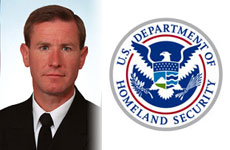Department of Homeland Security
-
DHS kicked off a global exercise to test the capabilities of the government, other nations and the private sector, in dealing with a possible attack on computer networks. The week-long test asks participants to deal with a scenario where the attack takes down the Web.
September 28, 2010 -
House Democrats went over the heads of Homeland Security Department officials and appealed to the White House to cancel a $1 billion financial management project, NextGov reports.
September 27, 2010 -
DHS\'s Sean McGurk and other cybersecurity experts are trying to protect agency networks against one of the most dangerous viruses ever developed. Stuxnet exploits a vulnerability in Siemens industrial equipment control software and hardware and may be the product of a nation bent on sabotage.
September 27, 2010 -
Administration\'s working group also is looking at policies and regulations that need to be updated. DoD calls on Congressional support when the White House submits its package of legislative changes. Meanwhile, DHS has released a draft of the National Cyber Incident Response Plan.
September 24, 2010 -
Who exactly is in charge of protecting the internet from a cyber attack? That\'s the question the White House and Congress are wrestling with.
September 24, 2010 -
Cyber Storm 3 will be unleashed next week on dozens of businesses and government agencies in several countries. The idea is to find out how well these organizations can withstand a national cyber incident.
September 22, 2010 -
Both employee unions and agencies say certain phrases in President Obama\'s executive order creating these committees need to be better defined. VA deputy secretary Gould will lead an effort to bring some precision to terms such as pre-decisional, to make sure everyone is working from the same sheet of paper. National Council on Federal-Labor Management Relations also details first set of bargaining pilots, called B-1.
September 22, 2010 -
David Silverberg is the editor of Homeland Security Today. He talked to Dorobek Insider producer, Scott Carr.
September 20, 2010 -
A new congressionally mandated report from the National Research Council, evaluates how DHS assesses potential national threats -- such as a terrorist attack, natural disaster, or pandemic -- to prioritize actions needed to reduce and mitigate such catastrophes. John Ahearne tells us about the findings.
September 20, 2010 -
Learn more in today\'s cybersecurity update
September 15, 2010 -
The arrest of Faisal Shahzad is a sign of things to come says CBP Commissioner Alan Bersin.
September 15, 2010 -
The new, border-wide use of the Predator aircraft marks an unprecedented amount of resources directed to the southwest. Michael Kostelnik, the Assistant Commissioner of the Office of Air and Marine for Customs and Border Protection explains.
September 14, 2010 -
HS Today editor David Silverberg spoke with DorobekINSIDER producer Scott Carr about other findings in the report card.
September 13, 2010




